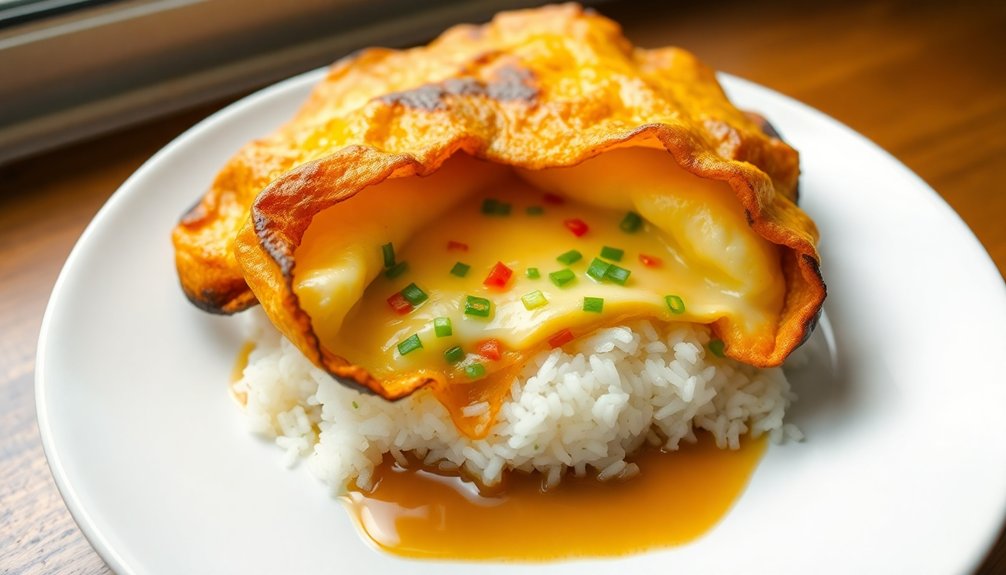Kai Jeow Moo Sap - Thai Omelet With Minced Chicken
You'll discover authentic Thai comfort food with Kai Jeow Moo Sap, a crispy-edged omelet filled with minced chicken and seasoned with fish sauce. This street food favorite combines vigorously beaten eggs with seasoned meat, fried in smoking-hot oil until golden brown and puffy. Serve it over steamed jasmine rice with prik nam pla (Thai chili fish sauce) for a satisfying meal. Master this technique, and you'll unveil the secrets of Thai home cooking.
Key Takeaways
- Kai Jeow Moo Sap is a traditional Thai omelet made with beaten eggs, minced meat, and seasoned with fish sauce and white pepper.
- The dish requires hot oil and vigorous egg beating to achieve its signature crispy exterior and fluffy interior texture.
- Originally prepared as home-cooked comfort food, it's now widely available in Thai street food stalls and restaurants.
- The dish is typically served over steamed jasmine rice and garnished with chopped green onions.
- Ground chicken can be substituted for traditional pork while maintaining the dish's authentic taste and preparation method.
History

While the exact origins of kai jeow moo sap aren't well documented, this Thai-style omelet emerged from humble beginnings as a quick, satisfying meal made in homes across Thailand.
In Thai cuisine, you'll find this dish has evolved from a simple protein-rich breakfast into a beloved staple served throughout the day. The combination of eggs and minced meat reflects the resourcefulness of Thai home cooks who learned to create flavorful meals with readily available ingredients.
Over time, it gained cultural significance as comfort food that embodied the Thai philosophy of balancing textures and tastes. You'll now see kai jeow moo sap featured in street food stalls, local restaurants, and modern Thai cookbooks, cementing its place as an enduring example of practical yet delicious Thai home cooking.
Recipe

INGREDIENTS:
- 2-3 eggs
- 100g ground pork
- 1 tablespoon fish sauce
- 1/4 teaspoon ground white pepper
- 2 tablespoons vegetable oil
- Green onions (chopped) for garnish
INSTRUCTIONS:
- In a bowl, beat the eggs until well combined.
- Mix in the ground pork, fish sauce, and white pepper.
- Heat oil in a wok or skillet over medium-high heat until hot.
- Pour in the egg mixture, allowing it to spread.
- Cook for 2-3 minutes until the bottom is golden brown.
- Using a spatula, flip the omelet and cook for another 1-2 minutes.
- Verify the pork is fully cooked through.
- Transfer to a serving plate.
- Garnish with chopped green onions.
- Serve hot with steamed rice.
Cooking Steps

You'll begin by vigorously beating the eggs until they're frothy and properly aerated, while heating your wok until the oil shimmers with intense heat.
Next, add your pre-seasoned minced chicken to the hot oil, then quickly pour the beaten eggs directly over the cooking meat.
Once the edges start to crisp and brown, flip the omelette in one swift motion and cook until both sides achieve a golden-brown finish with slightly crispy edges.
Step 1. Beat Eggs Until Frothy
Breaking and whisking the eggs thoroughly is an essential step in creating the perfect Thai-style omelet. The egg frothing technique contributes greatly to the final texture, creating those signature crispy edges and fluffy interior that sets kai jeow apart from other omelets.
- Crack your eggs into a medium bowl and add a splash of fish sauce - you'll want to incorporate enough air while beating to achieve a pale yellow color.
- Using chopsticks or a whisk, beat the eggs vigorously with a quick up-and-down motion for at least 30 seconds until you see plenty of bubbles forming.
- Test the texture importance by lifting your whisk - the egg mixture should fall in ribbons and maintain small bubbles throughout, indicating you've incorporated sufficient air.
Step 2. Heat Oil Until Shimmering
Getting your oil temperature perfect is the most critical step for achieving the signature puffy texture and golden-brown exterior of kai jeow moo sap.
In a small wok or 8-inch skillet, pour about 3 tablespoons of vegetable oil and heat it over medium-high heat.
You'll want to watch for the shimmering effect - that moment when the oil's surface ripples and appears to dance. If you drop a tiny bit of egg into the oil, it should immediately sizzle and bubble vigorously.
Don't let the oil smoke, as this means it's too hot and will burn your omelet. When you see that characteristic shimmering across the entire surface and tiny wisps of steam rising, you've reached the ideal oil temperature for creating that perfectly crispy, puffy Thai omelet.
Step 3. Add Seasoned Minced Chicken
The next critical step centers on adding your pre-seasoned minced chicken to the beaten eggs. For ideal flavor enhancement and spice balance, you'll want to incorporate the chicken mixture evenly throughout the eggs before cooking.
- Stir the minced chicken into your beaten eggs using chopsticks or a fork, guaranteeing even distribution without creating too many air bubbles.
- Let the mixture rest for 30 seconds to allow the seasonings to meld with the eggs completely.
- Pour the entire egg-chicken mixture into the center of your hot wok or pan in a smooth, controlled motion.
This technique guarantees that each bite of your Kai Jeow Moo Sap contains a perfect balance of tender chicken and fluffy egg, creating the authentic Thai street food texture you're aiming for.
Step 4. Pour Beaten Eggs Over Chicken
Now that your egg and chicken mixture is ready, mastering proper pouring technique will determine the final texture of your Kai Jeow Moo Sap.
Pour the beaten eggs in a circular motion from a height of about 6 inches above your hot wok. This creates small air pockets that'll give your omelet its signature fluffy texture while ensuring proper egg consistency throughout.
As the eggs hit the hot oil, they'll immediately start to bubble and crisp around the edges.
Don't worry if you hear a sizzling sound - this means you're achieving the right temperature for ideal flavor infusion between the chicken and eggs.
Let the edges set for about 30 seconds before you attempt to flip the omelet. The center should still be slightly runny at this point.
Step 5. Flip Until Golden Brown
Watch carefully for the edges to turn golden brown and crispy before attempting your first flip - this typically takes 1-2 minutes depending on your heat level.
The flipping technique variation is essential for achieving that signature Thai omelet texture.
- Use a spatula to gently lift one edge, ensuring the bottom has achieved a deep golden color and the edges are crispy.
- In one swift motion, flip the omelet - you can use either the spatula technique or the pan-flip cooking method if you're confident.
- Cook the second side for just 30-45 seconds until golden brown, being careful not to overcook as this will make your omelet tough.
The goal is to achieve a crispy exterior while maintaining a slightly runny center - this creates the authentic Thai street food texture you're looking for.
Cooking Tips

For ideal results when cooking Kai Jeow Moo Sap, you'll need to master a few critical techniques. Heat your oil until it's smoking hot - this guarantees your omelet will puff up properly.
Don't skimp on the oil; you'll need enough to create that signature crispy exterior.
When beating the eggs, incorporate air vigorously to achieve fluffiness. If you can't find minced pork, you can make ingredient substitutions with ground chicken or turkey, though pork remains traditional.
The fish sauce is non-negotiable for authentic flavor, but if you must, substitute with a pinch of salt.
Your pan should be wok-shaped or have high sides to contain the oil splatter.
Once you've mastered these cooking techniques, you'll consistently achieve that coveted combination of crispy exterior and fluffy interior.
Final Thoughts

While mastering Kai Jeow Moo Sap takes practice, this beloved Thai street food staple rewards your efforts with an irresistible combination of textures and flavors.
To make the most of your Thai omelet experience:
- Embrace the distinctive flavor profile by serving it over steaming jasmine rice with prik nam pla (Thai chili fish sauce) on the side.
- Don't hesitate to adjust the protein - while pork is traditional, chicken or even tofu can work equally well while maintaining authenticity.
- Consider serving suggestions beyond rice - try it with som tam (green papaya salad) or wrapped in fresh lettuce leaves for a lighter meal.
Frequently Asked Questions
Can I Substitute Minced Pork or Beef for the Chicken?
You can definitely substitute any minced meat in your omelet. While pork's the most traditional choice, beef works too - these flavor variations will give you equally delicious results.
How Long Can I Store Leftover Thai Omelet in the Refrigerator?
For ideal food safety, you'll want to store your leftover omelet in an airtight container and consume it within 2-3 days. Don't keep it longer, as egg dishes spoil quickly.
What Are Traditional Side Dishes Served With Kai Jeow?

Is This Dish Typically Eaten for Breakfast, Lunch, or Dinner?
You'll find this versatile dish served at any mealtime in Thailand. While it's popular for breakfast variations, locals enjoy it equally for lunch and dinner meal pairings throughout the day.
Why Does My Omelet Deflate Quickly After Taking It Out of Oil?
Your omelet's deflating because you're not using high enough heat or the right cooking technique. Heat your oil until it's smoking hot and guarantee you're beating the eggs vigorously for better texture retention.

